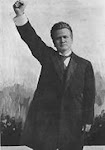As you may know, the 2011-2013 Biennial Budget passed by Republicans and signed by Governor Walker gutted $1.6 billion in funding for our local public schools while also funneling money into private voucher schools. With the introduction of Governor Walker's second budget, it appears the trend to devalue our children's need for a quality education is continuing. Not only does the newly introduced budget provide a 0% increase in revenue limit growth, but it also continues to divert money to an unaccountable, unproven voucher experiment. This time around, the budget also tries to create a voucher 2.0 program by altering the existing format of our charter schools to make them more closely resemble their voucher school counterparts. Continue reading for more information about the proposed changes to Wisconsin's charter and voucher school programs.Implications of Creating a Charter School BoardWhile many Wisconsinites are aware of the proposed expansion of voucher schools in Wisconsin, the same cannot be said of plans to further privatize education in our state by creating a Charter School Oversight Board (CSOB), which would be attached to Wisconsin's Department of Public Instruction (DPI), but ultimately act independently.Under Governor Walker's budget, school boards could convert all of the public schools within the district to charter schools. Further, should the area school board opt to convert all schools into charter schools, all students in the district could be forced to attend them. Likewise, parents and teachers in the district would have no say about the decision. Being forced to attend charter schools created under this plan rather than a traditional school or a charter school run under the guidance of DPI should be concerning to parents for several reasons. Not only will the Board creating these charter schools be controlled by a one-party majority, but it will also face little public scrutiny, can opt to ignore the local school board, and will have sole discretion over the charter school's budget, curriculum, and personnel policies and decisions.The Board created would be comprised of the state superintendent and 10 other members--two appointed by the superintendent, two by the governor, and six by the leaders of the Senate and Assembly. Given that the Legislature and the Governor's office are currently controlled by one party, that will allow the majority Republican members to dictate charter school policy.Additionally, the CSOB would not be subject to any direct oversight by the Legislature, or the local school district. As a result, this new Board would be able to establish policies and standards without the public scrutiny of the rule-making process to which other agencies, including DPI, are currently subject. Such a provision also limits the input of parents and local government to craft educational policy that represents the needs and values of that community and those neighbors.Finally, as stated in Governor Walker's budget, all new independent charter schools must be established by contract and operated by a charter school governing board. The charter school operators are then granted sole discretion over the charter schools budget, curriculum, and personnel policies and decisions. One such personnel policy granted is that DPI will be required to grant a charter school teaching license to any person who has a bachelor's degree and demonstrates that he or she is proficient in the subject they intend to teach. The individual need not have had any teaching experience or experience with kids in general. Once they are granted a license, it is valid for three years and may be renewed.While it may seem that school districts statewide will have the choice to go charter or not, Governor Walker sought to eliminate this local control option, as well. According to the budget text, approval for new, independent charter schools will be needed from home districts, unless the district meets the criteria of having two schools within the district with bad report card grades. In that case, the creation of CSOB will automatically be triggered, despite any voiced objections from the school board. While charter schools have become a valuable option for families across Wisconsin, it is something that should have oversight from those providing the funding--neighborhood taxpayers. Likewise, the creation of an independent charter school board should also be put before community members. Unfortunately, Governor Walker's budget, as it stands, does neither.How Voucher and Neighborhood Schools CompareWith the introduction of Governor Walker's 2013-2015 Biennial Budget, our local public schools once again were dealt a devastating blow. Under the governor's budget, private voucher schools will not only be allowed to expand across the state, but they will also see a $73 million increase in funding and spending authority. This means up to a $1,400 per-pupil funding increase for the 25,000 students in voucher schools. In this very same budget, 870,000 Wisconsin children were ignored when a $0 revenue growth limit was instituted in their public neighborhood schools. As we look to protect the opportunities available to our K-12 students, we should also ensure that the choices we are offering are quality, transparent options that will help guarantee all our children are receiving the best education possible.
One choice that still requires vast improvement is Wisconsin's voucher schools. Not only do these schools lack the same accountability and transparency measures as their public school counterparts, but it appears we may be investing substantial taxpayer dollars in a choice that has not been proven to be any better for our children than our traditional neighborhood schools.
The issue of poor accountability and lack of transparency measures in voucher schools has been discussed since I was nine years old. Despite Governor Walker's repeated promises to finally bring accountability and transparency to all schools receiving taxpayer dollars--including voucher schools--he has yet to follow through. Children, parents, and taxpayers deserve to have basic accountability measures in place for all schools receiving public funds.
In addition to widespread concerns over the lack of accountability and transparency in Wisconsin's voucher schools, this program also comes at a substantial cost to taxpayers. In 2010, state law compelled Milwaukee Public Schools to levy over $50 million in taxes to subsidize the private and religious schools making up the voucher program, which amounts to 17% of the total Milwaukee Public Schools tax levy. This financial burden increased the financial responsibility of taxpayers in 2012 to 22.6% of the total Milwaukee Public Schools tax levy.In truth, Milwaukee taxpayers are now being billed for both the largest school district in the state, Milwaukee Public Schools, AND the fourth largest, which is what the Milwaukee Parental Choice Program has grown to be with 22,400 students in the last school year. The tax levy for the Milwaukee Parental Choice Program already exceeds the Milwaukee Metropolitan Sewerage District by nearly $10 million and is expected to exceed Milwaukee Area Technical Colleges in the next few years.
Unfortunately, by increasing the funding for Wisconsin's voucher schools we are doubling down on a failed system. For those looking to get the most precise snapshot of just how voucher school students are performing compared to their public school counterparts, they should look at data recently collected by the Department of Public Instruction. This data analyzes how all voucher and public school students in 4th, 8th and 10th grade performed in reading, math and science during the 2010-2011 school year. According to the data, Milwaukee Public School students outperformed voucher students in eight out of nine categories.
The Milwaukee Shepard Express also recently compiled information to compare Wisconsin's voucher schools to their Milwaukee Public School counterparts. Through data provided by the Public Policy Form Research Brief, February 2013; Department of Public Instruction; Wisconsin Legislative Fiscal Bureau; and the University of Arkansas School Choice Demonstration Project, they were able to create the comparison chart illustrated below.
MPS Vouchers Enrollment 79,130 24,941 Economically disadvantaged students 84% 79% Minority students 86% 80% African American students 56% 48% Hispanic 24% 24% White 14% 20% Special needs students 19% 2% Cost per pupil $9,812 $7,670 Religious schools 0 85% Students proficient in reading (WKCE 2011-12) 60% 57% Students proficient in math (WKCE 2011-12) 50% 41% Able to discriminate? No Yes Comply with open meetings and records laws? Yes No Teach religious-based curriculum? No Yes Licensed teachers required? Yes No Individualized Education Plan (IEP) for special needs students required? Yes No Students with disabilities proficient in reading 26% 18% Students with disabilities proficient in math 25% 10% Students with access to guidance counselors 100% 58% Students with access to AP high school courses 100% 59% Students with access to gifted and talented programs 100% 10%
It is clear that Wisconsin has to institute greater accountability and transparency measures in order to honestly examine whether the additional cost of this program is worth it to taxpayers, especially before it considers expansion. I encourage my colleagues on both sides of the aisle to join me in learning more about Wisconsin's voucher program and whether or not it is truly a better option for Wisconsin's children and future workers.
Thursday, March 14, 2013
Charter Schools: Separate and Unequal
The following is from the weekly e-newsletter from Senator Chris Larson. Pay particular close attention to the table near the end:
Labels:
Chris Larson,
Education
Subscribe to:
Post Comments (Atom)














Where can I get a copy of the chart?
ReplyDeleteYou'll have to copy and paste it.
DeleteThank you Chris(es)!
ReplyDelete